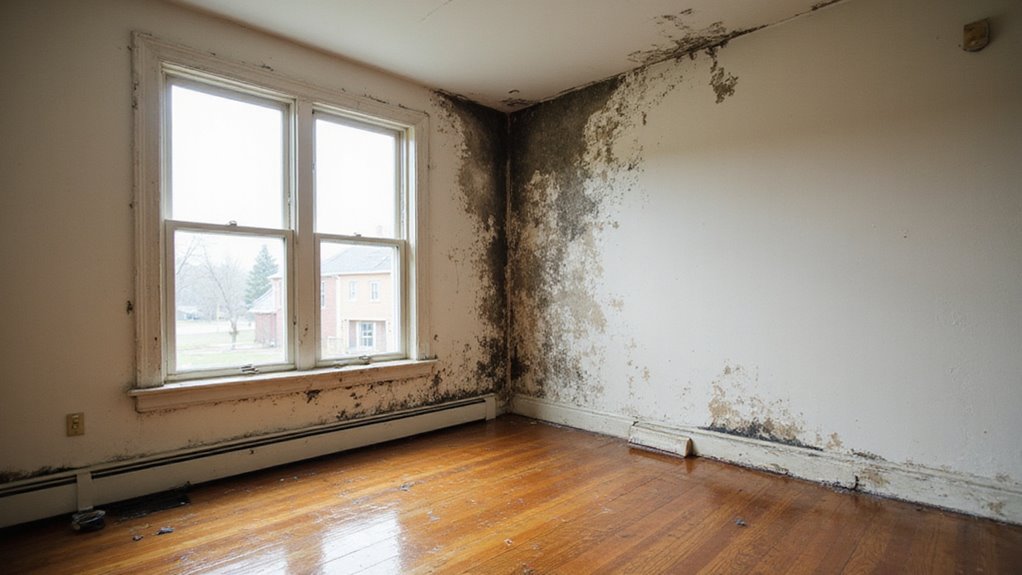Selling a House With Mold or Water Damage in Cincinnati




Selling a house with mold or water damage in Cincinnati is a real challenge. Many owners worry these issues will scare off buyers or lower their home’s value. Concerns about legal rules and repair costs only add to the stress.
This situation can feel overwhelming. Buyers might walk away, or you could face unexpected expenses. If you hide the damage, you risk legal trouble and ruined deals.
You can still sell your house with mold or water damage in Cincinnati if you take the right steps. Honest disclosure and smart repairs can protect you.
Local experts can guide you through the process for a smooth sale. This blog will show you how to handle mold or water damage and sell your house successfully in Cincinnati.
Table of Contents
Understanding Mold and Water Damage Impact

Mold and water damage can lower your home’s value and make it harder to sell. These problems are serious and should not be ignored. Fixing them quickly can save you money and stress later. Mold and water damage reduce your home’s value and market appeal, so addressing these issues early is essential.
In Cincinnati, many homes are old and have unique styles. Water damage or mold can cause even more problems in these houses. Repairing such damage is often more expensive and complicated in historic homes.
Homes with mold or water damage may sell for up to 30% less, according to the National Association of Realtors. Buyers worry about health risks and future repair costs. If your home is historic, keeping it in good shape is important to protect its value.
If you address mold and water issues right away, you help maintain your property’s worth and appeal. Fast action can also prevent more damage. This protects your investment and makes your home easier to sell.
Types of Water Damage and Mold Issues
You’ll need to consider the different types of water damage and mold issues that affect your home’s structure, your family’s health, and your property’s value. Hidden problems, like moisture behind walls, can go unnoticed and worsen over time, while insurance coverage often depends on the source and extent of the damage.
By identifying these risks early, you can make informed decisions that protect your investment and streamline your selling process. Water in your Cincinnati home can cause serious structural damage. This includes warped floors, weak foundations, and damaged support beams. Moisture can reduce your home’s strength by up to 40%.
Foundation problems, such as cracks or shifting, often signal hidden water issues. If these are ignored, your home’s value and safety could suffer. Acting quickly is important. A professional should check for structural damage right away. Repairs may include reinforcing joists, replacing floors, or fixing foundation cracks. Addressing these problems early can protect your investment and help with a smooth sale.
Health Concerns
Hidden Problems
Insurance Coverage
Water damage often leads to mold, which can harm your home’s air quality. Mold can appear within 24 to 48 hours after water exposure. This puts your family’s health at risk.
Mold releases spores that may cause allergies or breathing problems. Children and older adults are especially vulnerable to these health issues. The CDC states that mold exposure can cause coughing, wheezing, and worsen asthma.
If you plan to sell your home, visible mold or musty smells will turn buyers away. Buyers want clean, healthy homes. Fixing mold and water problems quickly protects your health and your home’s value.
Professional help is important if you find mold. Make sure to solve the problem and share the details with buyers if needed. Taking action early can prevent bigger health and financial concerns.
Hidden water damage and mold can exist even if you do not see them during a quick inspection. These issues may be behind walls, under floors, or in ceilings. They can weaken your home’s structure and lower its value.
Data shows that up to 60% of homes have hidden moisture problems. If you notice water stains or discoloration, there may have been leaks. Warped floors or peeling paint can also signal underlying moisture.
Musty odors often mean mold is growing in hidden places. Persistent allergy symptoms in your family could be caused by hidden mold. If you find these signs, you should investigate further.
Finding these problems early helps you fix them before they get worse. Early action can protect your investment and make your home safer. If you plan to sell, addressing these issues also protects your reputation.
Insurance coverage for water damage and mold can be limited. Most standard homeowners’ policies in Cincinnati only cover sudden water damage, like burst pipes. They do not cover gradual damage or issues caused by poor maintenance.
Mold coverage is also limited. Insurance will usually pay for mold cleanup only if it is caused by a covered event, such as a sudden leak. If your claim is denied, you must pay for repairs yourself.
Repair costs for water damage and mold in Ohio can range from $2,000 to $6,000. You should review your policy, keep records of all damage, and contact your insurer right away. Quick action can improve your chances of getting repairs covered and prevent more damage.
How to Address Mold and Water Damage
To tackle mold and water damage effectively, you’ll want a professional assessment to understand the scope and severity. Evaluate your remediation options, compare costs, and make sure you document everything for future buyers and legal requirements. Taking these steps positions you for a smoother sale and helps ensure compliance with Cincinnati regulations.
A professional assessment helps you understand how much mold or water damage is present. Inspectors find out where the problem started and how bad it is. This information is important if you want to protect your home’s value. Certified inspectors use tools to find hidden moisture and mold. They check behind walls and under floors to spot damage you might not see. If your home is old, inspectors may suggest special repairs.
The assessment includes a detailed report. This report explains the damage, health risks, and what you should do next. If you want eco-friendly repairs, the report can include those options. A clear assessment helps you plan the right solution. It gives you all the facts to take the next step. If you act quickly, you can prevent more damage.
Remediation Options
Cost Analysis
Documentation Needs
Choosing the right remediation method protects your property and your family’s health. Always stop the source of water first using reliable waterproofing. Remove damaged materials, and treat all affected areas with EPA-approved products.
Prevent mold by using dehumidifiers and improving airflow in your home. If the mold problem is severe, hire certified professionals for cleanup and documentation. Professionals have the right tools and knowledge for thorough removal.
The table below shows DIY and professional options for each step. If you want long-term results, consider professional services. Proper remediation keeps your home safe and meets Cincinnati’s standards.
Mold and water damage repairs can be expensive. The final cost depends on how serious and widespread the damage is. If you know the main costs, you can plan your budget better.
Mold removal usually costs between $500 and $6,000. Water damage repairs may cost $1,200 to $5,000 or more. Costs will rise if larger or harder-to-reach areas are affected.
Inspection fees are often between $200 and $600. These inspections help experts find all the damage. If you skip an inspection, you might miss hidden problems.
Labor makes up the biggest part of your bill. If more workers or extra time is needed, the price increases. Replacing damaged materials, like floors or walls, also adds to your total cost.
If you invest in prevention, you might avoid future repairs. Waterproofing or better ventilation can keep mold and water damage from coming back. These steps may cost more upfront but could save money later.
Accurate documentation is essential when selling a house with mold or water damage in Cincinnati. Buyers and inspectors will ask for proof of repairs. If you provide the right documents, you can build trust and possibly secure a better offer.
You should keep all inspection reports to show the extent of the damage. Remediation receipts prove that professionals removed the mold. Restoration invoices confirm that you repaired any water damage.
Photos taken before and after repairs give visual evidence of the work done. Warranty certificates can give buyers extra confidence if work comes with a guarantee. If you stay organized, the sale process will be smoother.
Legal Requirements for Selling
When selling a house with mold or water damage in Cincinnati, you must meet strict legal requirements. You’ll need to follow disclosure laws, comply with inspection protocols, and address any health regulations or insurance claims. Understanding these obligations helps you avoid costly penalties and ensures a smoother transaction.
Disclosure Laws
You must disclose any known mold or water damage when selling a house in Cincinnati. Ohio law requires sellers to share this information. If you hide these problems, you could face legal trouble or a cancelled sale.
Disclosure protects both buyers and sellers. You need to complete the Ohio Residential Property Disclosure Form before selling. This form should list any past water leaks, flooding, or mold issues.
You should also tell buyers about any repairs you made for these problems. Keeping receipts and repair records is important. If you do this, you show buyers that you are honest and responsible.
Proper disclosure can help build trust with buyers. It may also protect your neighborhood’s property values. Always update the forms if new issues appear before closing.
Inspection Requirements
A home inspection is not legally required before selling in Ohio. However, most Cincinnati buyers will still want one, especially if the home had mold or water damage. Inspections help buyers understand the real condition and costs involved.
An inspection often reveals hidden problems. Buyers may ask for repairs, request a lower price, or even end the deal if issues remain. Sellers should fix known problems before listing to avoid surprises.
If an inspection is needed, buyers expect clear information about mold, water damage, and repairs. Sellers should provide proof of professional mold removal and water damage repair. Maintenance records for things like HVAC systems also help build trust.
Inspectors will check for mold, water stains, and structural damage. They will also look at the attic and basement for dryness and mold. Proactive repairs and clear documentation help the sale go smoothly.
Health Regulations
Ohio law says you must tell buyers about mold or water damage when selling a home in Cincinnati. If you ignore these health rules, you could face legal or financial trouble. Sellers need to follow the law to protect themselves and buyers.
Homeowners must list all known mold or water problems on the Ohio Residential Property Disclosure Form. You should also share records of repairs or steps taken to fix these issues. If you have not fixed the problems, you must still mention them.
Your home needs to meet local health codes for air quality and mold prevention. Before selling, check that any repairs meet Ohio’s health rules. If you do not follow these regulations, you risk penalties or delays in your sale.
Insurance Claims
You must handle any insurance claims for mold or water damage before selling your Cincinnati home. Insurance companies may ask for a mold check and a review of all water damage. If you ignore these claims, you could face delays or lose money on the sale.
Complete all paperwork, such as inspection reports and repair receipts. Homes with open water damage claims can sell for up to 20% less. If you want to avoid problems, contact your insurance agent early.
Resolving claims before selling shows buyers you are honest. It also helps you follow the law. If you take care of claims first, your sale will go more smoothly.
Submit Your Information Below For A Cash Offer On Your Property
Options for Selling Water-Damaged Houses
When selling a house with water damage in Cincinnati, you’ve got several proven options to consider. You can sell as-is, make repairs before listing, or adjust your price to attract different types of buyers. Understanding how each approach impacts your sale timeline and bottom line helps you choose the best solution for your situation.
As-Is Sales
As-is sales let you sell your Cincinnati house without making repairs. This option is useful if your home has water damage or mold. Homeowners can avoid extra costs and sell faster.
If you choose as-is sales, you skip repairs and sell your home as it is. Cash buyers often make quick offers and close within days. Sellers do not have to worry about inspection delays.
Professionals will handle all the paperwork and legal steps. If you want a smooth transaction, as-is sales can be a good choice. This method helps you get financial relief quickly.
Post-Remediation Sales
Selling your Cincinnati home is easier after fixing water damage or mold. Buyers feel safe when they know problems are resolved. This confidence can help you sell your home for more money.
If you want to attract more buyers, consider home staging. Clean, refreshed spaces look appealing and help buyers picture themselves living there. Staged homes can also sell much faster than empty ones.
Interior renovation is another option if you want to increase your home’s value. New finishes and fixtures make the home look modern and durable. Buyers may pay more for homes that look move-in ready.
Professional photos are useful if you plan to list your home online. High-quality images show off the restored spaces and attract more interest. If you use these strategies, you can boost your chances of a successful sale.
Price Adjustments
If your Cincinnati home has water damage or mold, you may need to lower your asking price. Homes with these issues usually sell for 15%-30% less than similar homes in good shape. Price adjustments help attract buyers and reflect the true condition.
The amount of damage should be clearly documented, including any structural or garden problems. Repair estimates from professionals show buyers you are transparent and realistic. Accurate figures make negotiations smoother.
Neighborhood zoning can affect your home’s value if it allows for other uses or rebuilding. You should check local rules before setting your price. Zoning may increase or decrease what buyers are willing to pay.
Recent sales of similar damaged homes are useful for setting a fair price. Comparable sales help you stay competitive in the market. Using data ensures your price is realistic and supported by facts.
Buyer Types
Understanding buyer types helps you sell a home with water damage or mold. Most buyers for these properties are not regular homebuyers. Investors, cash buyers, and flippers look for homes they can repair and resell or rent out.
Owner-occupiers usually avoid homes with water damage because of risks and financing problems. If you want a faster sale, cash buyers and investors are good options. These buyers prefer simple, quick deals.
Below is a comparison of common buyer types:
| Buyer Type | Main Motivation |
|---|---|
| Cash Buyers | Fast, as-is purchases |
| Investors | Rental or resale profit |
| Flippers | Remodel and resell |
| Owner-Occupiers | Ready-to-move-in homes |
| Landlords | Low-cost rental deals |
Choosing the right buyer can make your sale easier and help protect your neighborhood’s value.
Markets We Buy Houses In
Get a Fair Offer on Your Damaged House from Prestige Investments Cincinnati Can Help
Prestige Investments Cincinnati offers fair cash offers for damaged houses in Cincinnati. If your home has mold or water damage, you can still sell it quickly. You do not need to fix anything before selling.
Owners can sell their homes as-is, regardless of the damage. Our team evaluates the property’s condition and current market value. If you accept our offer, you will not need to pay for repairs.
Sellers receive a competitive cash quote within 24 hours. Prestige Investments handles all the paperwork and legal details. We ensure clear communication and honest pricing throughout the process.
Selling a House With Mold or Water Damage in Cincinnati: Frequently Asked Questions
Can I sell my house in Cincinnati if it has mold or water damage?
Yes, you can. But you must disclose the damage to buyers. Many cash buyers and investors are willing to buy homes in “as-is” condition.
Do I need to fix the mold or water damage before selling?
Not always. If you’re selling to a traditional buyer, repairs may be expected. But if you sell to an investor or cash buyer, they’ll usually handle repairs themselves.
Will mold or water damage lower my home’s value?
Yes, it can. Mold and water issues can scare buyers and lead to lower offers. The cost of repairs is often factored into the price.
Who buys homes with mold or water damage in Cincinnati?
Cash buyers, home investors, and house-flipping companies often buy damaged homes. They specialize in repairs and quick sales.
How do I disclose mold or water damage to buyers?
Ohio law requires sellers to fill out a Residential Property Disclosure Form. You must list any known issues, including water damage or mold.
How fast can I sell a water-damaged house in Cincinnati?
If you sell to a cash buyer, the sale can close in as little as 7–10 days. Traditional sales may take longer, especially if repairs are needed.

